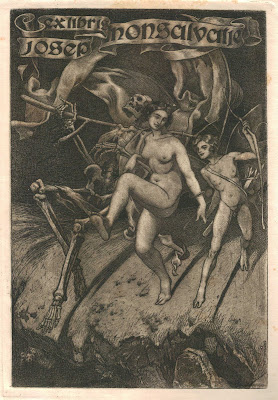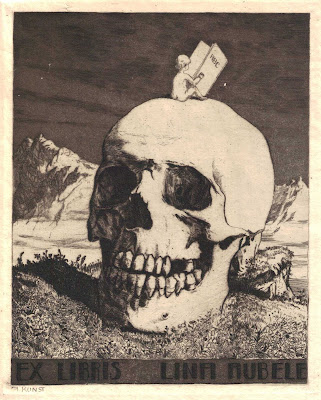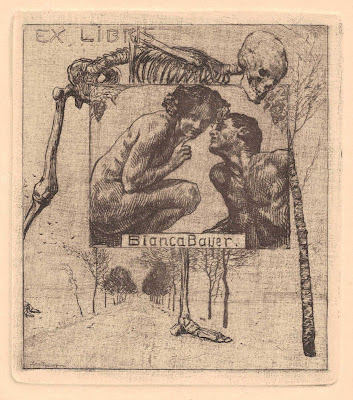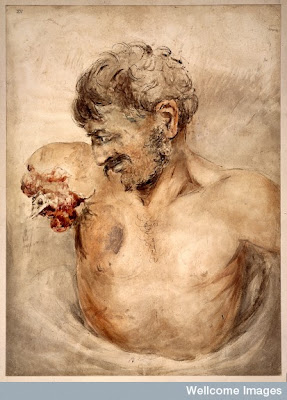 Ex Libris
Ex Libris "from the books of..." the so called "Bookplates" are usually small prints or decorative labels pasted into a book, often on the inside front cover, to indicate its owner.
 "What is to be will be"
"What is to be will be"Bookplates typically bear a name, motto, device, coat-of-arms, crest, badge, or any motif that relates to the owner of the book, or is requested by him from the artist or designer. The name of the owner usually follows an inscription such as "from the books of . . . " or "from the library of . . . ", or in Latin, ex libris .... Bookplates are important evidence for the provenance of books.
 "Sed omnis una manet nox
"Sed omnis una manet nox
(et calcanda semel via leti)""But one night waits for all
(and the road of death is to be tread once)' Horace(Carmina, Liber I, XXVIII)The artwork of ex libris was usually ornamental, heraldic with coat of arms or somethind simple, but some of them and during certain periods held allegorical, religious or philosophical contents, making them highy appreciated from artistic point of view. I present some with danse macabre and memento mori content, all taken from the very interesting blog
Journey Round my skull
Τα
Ex Libris ήταν τυπωμένα καλλιτεχνήματα σε μια από τις πρώτες σελίδες βιβλίων παλιότερων εποχών τα οποία ανέφεραν τον ιδιοκτήτη αυτού ή τη βιβλιοθήκη όπου ανήκαν. Συχνά ήταν περίτεχνες εικόνες, άλλοτε με θυρεούς, άλλοτε με αλληγορικές εικόνες θρησκευτικού, ή φιλοσοφικού περιεχομένου. θα παρουσιάσω μια σειρά από αυτά με danse macabre/memento mori θεματολογία, όλα παρμένα από το εξαιρετικό blog
Journey Round my skull
 artist: Michel Fingesten (1884 - 1943)
artist: Michel Fingesten (1884 - 1943) the righteous is afraid of death
the righteous is afraid of death







 artist: Michel Fingesten (1884 - 1943)
artist: Michel Fingesten (1884 - 1943)
 Things are going bad not only in my country Greece but all over Europe and the allegedly so called Western Free World seems to face a new totalitarianism by depriving any social and human rights that were gained with blood and great social upheavals and revolution in the past centuries. So wishes like "Merry Christmas and Happy New Year" and "Peace and Love everywhere" sound much more silly and meaningless than any other year, because crisis is now knocking our door, is not far from our ass anymore!!!!
Things are going bad not only in my country Greece but all over Europe and the allegedly so called Western Free World seems to face a new totalitarianism by depriving any social and human rights that were gained with blood and great social upheavals and revolution in the past centuries. So wishes like "Merry Christmas and Happy New Year" and "Peace and Love everywhere" sound much more silly and meaningless than any other year, because crisis is now knocking our door, is not far from our ass anymore!!!! Happy New Fear:
Happy New Fear: 




































































.jpg)



